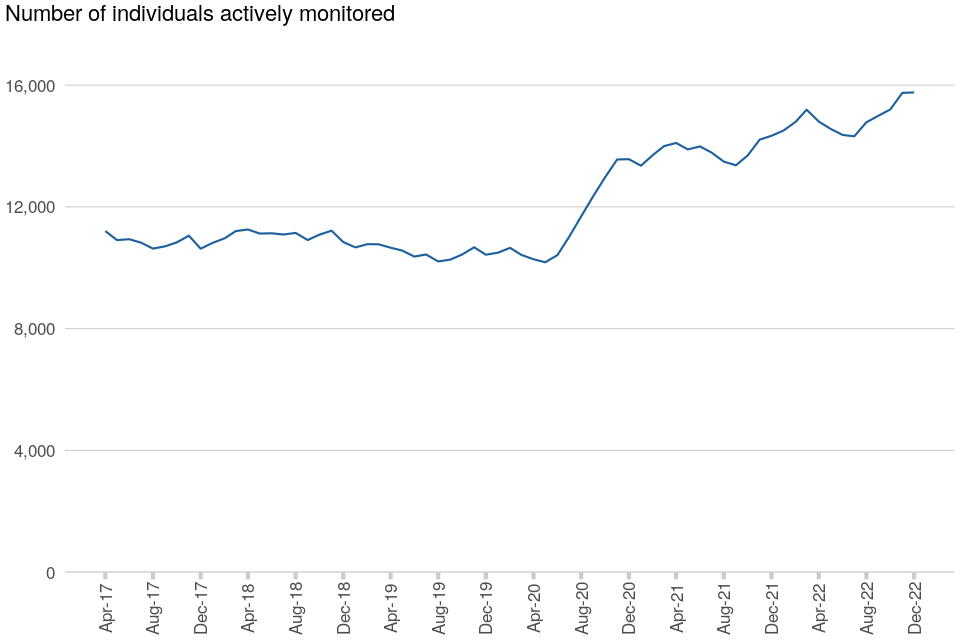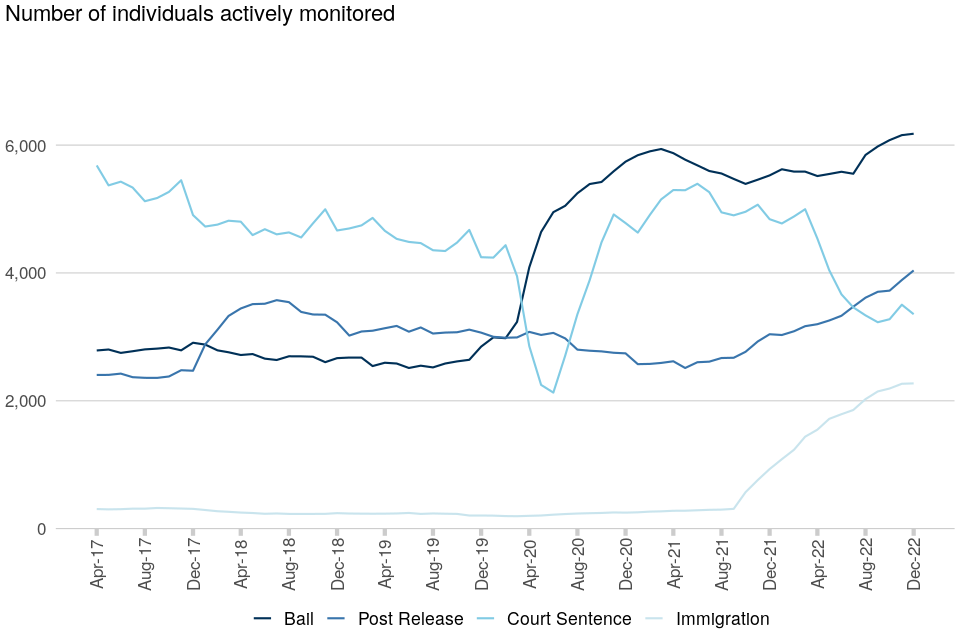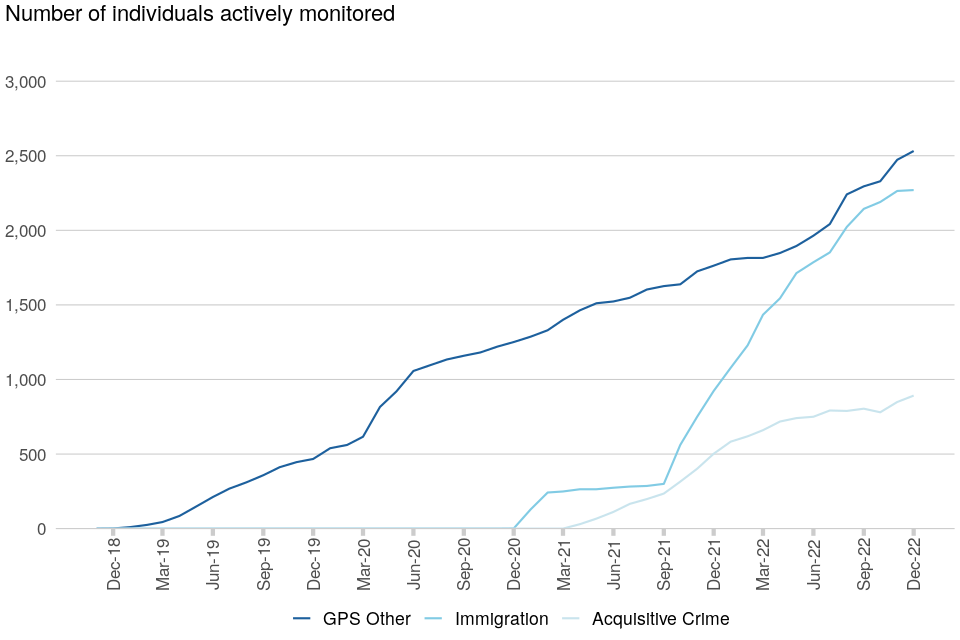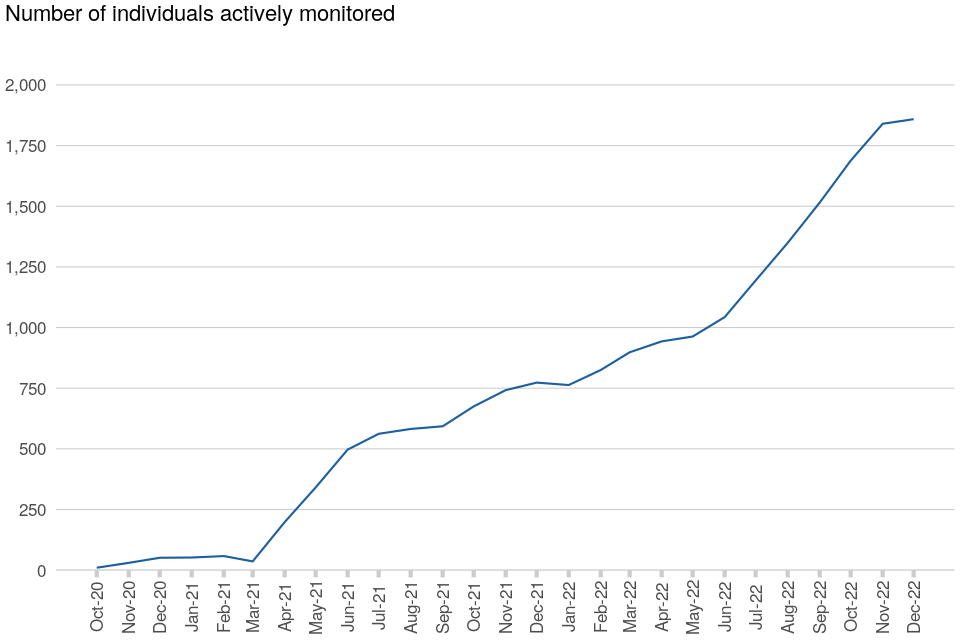Electronic Monitoring Statistics Publication, England and Wales: December 2022
Published 19 January 2023
Main Points
This publication sets out statistics on the use of electronic monitoring from 31 December 2021 to 31 December 2022.
| The number of individuals being actively monitored increased by 10% | At 31 December 2022, the total number of individuals actively monitored was 15,760, an increase from 14,335 as at 31 December 2021. |
| Court bail orders remains the largest cohort of individuals actively monitored by an electronic monitoring device | The number of individuals actively monitored under a court bail order increased by 12%, from 5,526 as at 31 December 2021 to 6,178 as at 31 December 2022. Court bail accounts for 39% of all individuals actively monitored. |
| The number of individuals being actively monitored with a location monitoring device (GPS) accounts for 36% of monitored individuals | Between 31 December 2021 and 31 December 2022 the number of individuals actively monitored with a location monitoring device (GPS) increased by 79% (from 3,188 to 5,694). This increase is the result of the continued rollout of electronic monitoring to new offender cohorts, particularly immigration bail. |
| The number of individuals being actively monitored with an alcohol monitoring device has more than doubled | As at 31 December 2022, 1,859 individuals were actively monitored with an alcohol monitoring device, a 140% increase from 773 as at 31 December 2021. This increase reflects the national rollout of alcohol monitoring for prison leavers from June 2022. |
Statistician’s comment
Between 31 December 2021 and 31 December 2022 the number of individuals actively monitored increased. This increase was driven by extensions to the use of location (GPS) monitoring tags for new offender cohorts, particularly for immigration bail, as well as the continued rollout of alcohol monitoring tags. However, over the same period the number of individuals actively monitored and whose primary order type was a court sentence has decreased by 31%. This decrease began from April 2022 and is likely to be associated with mandating domestic abuse and safeguarding checks in all cases where electronic monitoring is proposed, which was introduced from April 2022.
Court bail orders remain the largest cohort of individuals actively monitored by an electronic monitoring device, accounting for 39% (6,178) of the 31 December 2022 caseload. The use of electronic monitoring for those on court bail increased sharply in early 2020 in response to the covid pandemic’s impact on the courts. Although numbers appeared to be slowly decreasing in 2021, the number is now at a record level.
In the year ending 31 December 2022 there were 54,477 new order notifications, a 2% decrease compared to the year ending 31 December 2021. However, in the same period there were 51,489 completed orders, a 7% decrease on the previous period. This, together with the increasing caseload, indicates orders are on average lasting longer.
This release is part of the Electronic Monitoring Statistics publication series. Feedback on the content and format of the release is welcome - please see contact details section for further information.
Background
Electronic monitoring supports the police, courts, prisons and the wider justice system in England and Wales. It is a way of remotely monitoring and recording information on an individual’s whereabouts or movements and alcohol consumption, using an electronic tag which is normally fitted to a subject’s ankle. Information about the compliance with an individual’s order is monitored. Electronic monitoring may be used:
as a condition of court bail;
as a requirement of a court sentence, primarily community orders and suspended sentence orders;
for Home Detention Curfew;
as a licence condition following release from custody;
as a condition of immigration bail, managed by the Home Office; or
to intensively monitor a small number of individuals including: some of the highest risk offenders managed under Multi-Agency Public Protection Arrangements (MAPPA); those granted bail by the Special Immigration Appeals Commission (SIAC); and those made subject to Terrorism Prevention and Investigation Measures (TPIMs).
Electronic monitoring was first introduced in 1999 to monitor compliance with curfews using radio frequency (RF) tags. This was expanded from November 2018 to introduce satellite enabled (GPS) location monitoring tags. The tags use GPS technology to record an individual’s movements 24 hours a day. Rollout was fully completed in March 2021 when the provision of GPS monitoring was extended to under 18s.
GPS tags provide additional functionality, allowing the monitoring of:
-
compliance with exclusion zones;
-
attendance at a required activity or appointment;
-
an offender’s whereabouts (trail monitoring);
-
multiple conditions or requirements if necessary, such as a combination of exclusion zones, curfew, monitored attendance and trail monitoring.
More recently HMPPS has expanded the use of GPS tags to two offender cohorts:
-
acquisitive crime: From April 2021 they have been used as a licence condition for adult offenders convicted of acquisitive crime as their principal offence and who have received a custodial sentence of 12 months or more and been released on licence. This is currently being piloted by 19 police forces. In late October 2022 this was expanded to those who had received a custodial sentence of 90 days or more and been released on licence.
-
immigration expansion: The Immigration Act 2016 introduced a duty on the Home Office Secretary of State to impose an electronic monitoring condition on Foreign National Offenders and other non-UK citizens subject to deportation proceedings. Following this, in August 2021, HMPPS began using GPS monitoring for those individuals who had been released from Prisons or Immigration Detention under ‘Immigration Bail’ on behalf of the Home Office. From 31 August 2022 this was extended to Scotland and Northern Ireland in December 2022.
Electronic monitoring using a non-fitted device was introduced in November 2022 for the immigration cohort. These devices utilise periodic biometric verification as an alternative to using fitted devices.
Alcohol monitoring was introduced to courts in Wales in October 2020 and expanded to courts in England on 31 March 2021 to support the new community sentencing option, the Alcohol Abstinence and Monitoring Requirement (AAMR). An AAMR may only be used when sentencing for alcohol-related criminal behaviour and it imposes a total ban on drinking alcohol for up to 120 days. Compliance with the ban is monitored electronically using an alcohol tag which continuously monitors for the presence of alcohol in offenders’ sweat.
It may be imposed by the court as part of a community order or suspended sentence order where:
-
the offence, or associated offence, for which the requirement is being imposed, is alcohol-related;
-
the subject is not alcohol dependent or has an Alcohol Treatment Requirement (ATR) recommended or in place; and
-
the subject is an adult (18 years or over)
For offenders being released from custody whose offending and risk is alcohol related, an Alcohol Monitoring on Licence (AML) additional licence condition was introduced in Wales in November 2021 and rolled out in England in June 2022. There are two licence conditions available for AML:
-
requires total abstinence from alcohol, or
-
requires the offender to comply with requirements specified by their Probation Practitioner to address their alcohol needs, this will include limiting alcohol use.
1. Overall Summary
An individual may be given several orders at the same time and/or over the course of a year. Therefore there will be more active orders at any one time than there are people being monitored. If an individual has multiple orders, when looking at order notification each will be counted separately. However, when counting individuals, the subject will be included in a order cohort once according to a defined formula, unless an individual is fitted with both an alcohol and RF or GPS tag, in which case they will be counted twice. This is why the number of dual tagged individuals need to be subtracted to correctly count the number of individuals. Please see the technical note for more details.
At 31 December 2022, the total number of individuals actively monitored with an electronic monitoring device (a radio frequency device for Home Detention Curfews or location device) or an alcohol monitoring device was 15,760, an increase of 10% compared with 31 December 2021. Although the monthly figures fluctuate, the trend over the 12-month period has been upwards.
Figure 1: Overall number of individuals with an active Electronic Monitoring or Alcohol Monitoring Device, England and Wales, as at month-end, from April 2017 to December 2022 (Source: Table 1.4)

!!1
However, the caseload mix differs considerably by type of order in both absolute number and trend over time:
court bail orders make up the largest proportion (39%) of electronically monitored individuals. At 31 December 2022, 6,178 individuals had court bail as their primary order type, up by 12% on the previous year.
post-release orders was the second largest group with 4,039 individuals (26% of the caseload), up by 33% when compared with the previous year. This increase is mainly due to the national rollout of alcohol monitoring to this group.
court sentences (community orders and suspended sentence orders) was the third largest group with 3,354 individuals (21% of the caseload), down by 31% on the same point in the previous year.
immigration orders was the fourth largest group with 2,272 individuals (14% of the caseload).
Figure 2: Individuals actively monitored by an electronic monitoring or alcohol monitoring device, by order type (excluding Specials), England and Wales, as at month-end, from April 2017 to December 2022 (Source: Table 1.4)

!!2
2. Location (GPS) Monitoring
Between 31 December 2021 and 31 December 2022 the number of individuals monitored using a GPS tag increased from 3,188 people to 5,694. Over the same period the proportion of all monitored subjects that have a GPS tag increased from 22% to 36%. This increase in the numbers and relative use of GPS tags is the result of expanding the use of electronic monitoring to new offender cohorts, particularly immigration bail. As at 31 December 2022 GPS immigration bail accounted for 40% of all individuals with a GPS tag.
There were 1,738 new acquisitive crime orders imposed across England and Wales in the year ending 31 December 2022. Overall, 2,539 new acquisitive crime orders have been imposed since they were introduced.
Figure 3: Acquisitive Crimes Offenders and Foreign National Offenders, England and Wales, as at month-end, December 2018 to December 2022 (Source: Table 2.2)

!!3
3. Alcohol Monitoring
There were 6,447 new alcohol monitoring orders imposed across England and Wales in the year ending 31 December 2022, a large increase from the 2,567 seen in the year ending 31 December 2021. This primarily reflects the national rollout of alcohol monitoring as a sentencing option and its expansion to the post-release cohort. Correspondingly the number of individuals with an alcohol monitoring tag increased from 773 as at 31 December 2021 to 1,859 as at 31 December 2022. Overall 9,070 new alcohol monitoring orders have been imposed since their introduction.
Of the alcohol tags in use to monitor alcohol abstinence and monitoring requirements (AAMR) over the last quarter, between September 2022 and December 2022, the tags did not register a tamper or alcohol alert 97.0% of the time. Since their introduction in October 2020, the tags did not register a tamper or alcohol alert 97.1% of the time.
Figure 4: Overall number of individuals with an Alcohol Monitoring Order, England and Wales, as at month-end, October 2020 to December 2022 (Source: Table 3.1)

!!4
Further information
Accompanying files
As well as this bulletin, the following products are published as part of this release:
-
Tables
-
Technical note
Data Quality
The statistics in this bulletin are classified as official statistics. The Statistics and Registration Service Act 2007 defines ‘official statistics’ as all those statistical outputs produced by the UK Statistics Authority’s executive office (the Office for National Statistics), by central Government departments and agencies, by the devolved administrations in Northern Ireland, Scotland and Wales, and by other Crown bodies (over 200 bodies in total). The statistics in this bulletin comply with all aspects of the Code of Practice for Official Statistics. The Code encourages and supports producers of statistics to maintain their independence and to ensure adequate resourcing for statistical production. It helps producers and users of statistics by setting out the necessary principles and practices to produce statistics that are trustworthy, high quality and of public value.
This publication has been produced to the high professional standards as set out in the Code of Practice for Statistics. However, the analysis is only as good as the data upon which it is based, and there is inherent uncertainty when the data is derived from diverse administrative data systems.
Following the introduction of a more automated and systematic process for adjusting the data for known data quality issues in the previous release, some minor adjustments have been made to improve the coding used. This has resulted in some small changes to the overall numbers of actively monitored individuals. In advance of the next release we will be reviewing, with the Home Office, the methodology used for adjusting the number of actively monitored individuals within the immigration cohort. This may result in some revisions to the figures.
For further details on the methodology used to compile the report, please refer to the technical note.
Future publications
Our statisticians regularly review the content of publications. Development of new and improved statistical outputs is usually dependent on reallocating existing resources. As part of our continual review and prioritisation, we welcome user feedback on existing outputs including content, breadth, frequency and methodology. Please send any comments you have on this publication including suggestions for further developments or reductions in content.
Contact
Press enquiries should be directed to the Ministry of Justice press office: Tel: 020 3334 3536 Email: newsdesk@justice.gov.uk
Other enquiries about these statistics should be directed to Data and Analysis at the Ministry of Justice:
Julie Sullivan
HMPPS Electronic Monitoring Performance
Data and Analysis
Ministry of Justice
10th Floor
102 Petty France
London
SW1H 9AJ
Email: statistics.enquiries@justice.gov.uk
Next update: April 2023
© Crown copyright Produced by the Ministry of Justice
Alternative formats are available on request from statistics.enquiries@justice.gov.uk
